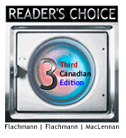

Reader's Choice is based on the assumption that lucid writing follows lucid thinking, whereas poor writing is almost inevitably the product of foggy, irrational thought processes. As a result, our primary purpose in this book, as in the first edition, is to help students think more clearly and logically--both in their minds and on paper.Reading and writing are companion activities that involve students in the creation of thought and meaning--either as readers interpreting a text or as writers constructing one. Clear thinking, then, is the pivotal point that joins together these two efforts. Although studying the rhetorical strategies presented in Reader's Choice is certainly not the only way to approach writing, it is a productive means of helping students improve their abilities to think, read, and write on progressively more sophisticated levels.
The symbiosis we envision among thinking, reading, and writing is represented in this text by the following hierarchy of cognitive levels:
- Literal, characterized by a basic understanding of words and their meanings;
- Interpretive, consisting of a knowledge of linear connections between ideas and an ability to make valid inferences based on those ideas; and
- Critical, the highest level, distinguished by the systematic investigation of complex ideas and by the analysis of their relationship to the world around us.
We have made some changes in the third edition of Reader's Choice that represent the responses of reviewers from many different types of colleges and universities all over Canada and the United States: WHAT IS NEW
The third edition of Reader's Choice contains 19 new essays.
We have updated some of the selections, added new authors, and introduced new topics, such as regional traditions, and national identity, infomercials, the monument at Vimy Ridge, ethics in journalism, welfare reform, and war.A new set of questions called "Making Connections" has been added to each essay.
The "Making Connections" questions make links between the various readings throughout the book, reinforcing rhetorical strategies that are used and providing further opportunities for writing and discussion on the topics the writers address.This edition includes new user-friendly checklists at the end of each chapter introduction.
These checklists summarize the information in the chapter introduction and serve as references for the students as they complete their own writing tasks.We have completely renovated Chapter 10 on Documented Essays.
It now includes two new essays that deal with important current issues. In addition, the essays illustrate two different documentation styles: Modern Language Association (MLA) and American Psychological Association (APA).This web site - www.prenticehall.ca/readerschoice
Features a glossary of useful terms for students to use in conjunction with this book.I would like to acknowledge a number of people who helped in the preparation of this edition of Reader's Choice. At Prentice-Hall Canada, for their guidance, patience, and support, I would like to thank David Stover, Acquisitions Editor; Susan RatkaJ, Developmental Editor; Cathy Zerbst, Production Editor; and Diana Thistle-Tremblay, Copy Editor. ACKNOWLEDGMENTS
At Seneca College, I am grateful to my colleagues, especially Sarah Reid, Enid Gossin, Judith Carson, and Andrea Medovarski, as well as my students in College English, for their ongoing feedback and advice about Reader's Choice.
Alexandra MacLennan